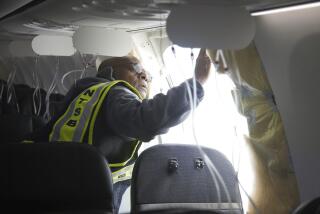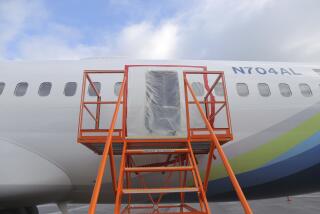TWA Debris Yields More Explosive
NEW YORK — Federal officials have discovered more residue from an explosive on debris from Trans World Airlines Flight 800, they said Friday, raising the prospect that, even though the investigation is grinding along slowly, they are closer to declaring the crash the result of a criminal act.
The discovery of additional explosive residue in the center of the airplane, where similar traces were found earlier this month, is a striking development in the 6-week-old investigation that had been remarkable only for what it was failing to accomplish.
Until now, investigators have come up against repeated dead-ends in their efforts to determine the cause of the July 17 explosion. Even with more than 70% of the plane’s wreckage recovered, the FBI, the National Transportation Safety Board and the Navy have had the glum task of reporting in daily briefings that none of the pieces of debris showed any signs of a bomb, a missile or a mechanical malfunction.
Even while trumpeting the new find of “microscopic explosive traces of unknown origin” on Friday, investigators just as quickly cautioned that they still are not yet ready to call the tragedy a crime or an accident.
In a rare joint FBI-NTSB statement, officials said: “Based upon the evidence to date, investigators still cannot conclude whether this tragedy was the result of a criminal act.
“The detection of the microscopic explosive traces alone does not allow the conclusion that TWA Flight 800 crashed as a result of an explosive device.
“Other evidence of some kind, for example physical damage or patterns characteristic of a detonation, would need to be available, in addition to confirmed explosives trace findings, before a positive conclusion of an explosive device could be made.”
James K. Kallstrom, the FBI assistant director in charge of the criminal investigation, said that authorities decided to announce the discovery of additional residue to keep the public fully informed.
Specifically, he said, “the traveling public.”
“That information has been and will continue to be expeditiously shared,” he pledged.
*
But officials also refused adamantly to discuss any more details about the latest discovery. Sources close to the investigation, however, described it as an explosive material often used with PETN, a plastic explosive material found on some debris in mid-August.
The sources said the residue was RDX, a high-energy plastic explosive consisting of colorless crystals. RDX can last a fairly long time embedded in fibers, even in salt water, explosives experts said. When mixed with PETN, it creates Semtex, which was used eight years ago to blow up Pan Am Flight 103 over Lockerbie, Scotland.
Both traces, so small that microscopic analysis was needed to detect them, were found by FBI scientists working in the bureau’s laboratory in Washington.
Joseph Valiquette, an FBI spokesman here, said that all of the wreckage is first examined by experts at mobile labs on Long Island. Then, he said, some of the material is sent to Washington for further review.
“Everything that comes up has to undergo some sort of analysis,” he said. “For those pieces that show some promise, we look at them further to see where it is they might go.”
Sources said that both traces of explosive residue were found along floorboards in the central part of the 747 jetliner, between rows 17 and 28. Officials believe that the explosion originated in this area, severing the front of the plane and sending all 230 crew members and passengers to their deaths in the waters off Long Island.
In recent weeks, NTSB experts and FBI agents have been concentrating their efforts on this part of the aircraft.
*
To that end, they have set up a computer simulation that has suggested to investigators that the impact of the initial explosion blew out the right side of the airplane above and ahead of the wing.
But just as officials have announced limited progress toward declaring some kind of cause for the disaster, other possibilities have arisen to dampen that success.
For instance, Kallstrom said this week that the TWA plane had been used in recent years by the Pentagon to transport U.S. military personnel to and from the Middle East.
A soldier working with Army ordnance could have inadvertently left traces of explosives on the plane from his clothing, boots or duffel bag.
But Kallstrom himself cast doubt on that scenario.
At a regular news briefing Thursday in Smithtown, N.Y., Kallstrom said that he knew of only one occasion when the plane was used to transport military personnel after the plane’s carpeting was refurbished two years ago. Therefore, he concluded, it was “less likely” that the residue was accidentally left on the plane by someone in the military.
But after the briefing, when he was asked to expand on that statement, Kallstrom cautioned that the public should not “read too much” into his earlier comment. He added that it is still possible that the residue was from a soldier.
Using a phrase he has repeated over and over, he said: “Everything’s still on the board.”
As the plane wreckage has been slowly retrieved from the ocean floor, nothing yet has come close to what authorities call the “golden nugget” of evidence explaining why the New York-to-Paris aircraft exploded just 11 1/2 minutes after taking off from John F. Kennedy International Airport.
Despite the tremendous odds against finding evidence in the water, Kallstrom said, he remains “confident” that a cause will be assigned to the air crash.
Nevertheless, the investigation so far has been marked by what investigators have not found. Some examples:
* The cockpit and flight recorders revealed no sign that the crew had any warning of disaster. Instead, the tapes ended abruptly with a short, unexplainable cutoff noise.
* The cockpit’s control panels have provided no hints of catastrophe. In fact, some of the glass on the instrument gauges and around a lightbulb was intact.
* The four large containers in the front cargo hold, seen as a prime hiding spot for a bomb, turned up no evidence of a major blast from an explosion.
* And the plane’s four engines were examined and discovered to show no signs of a major explosion. That is a finding that seems to discredit the theory that a heat-seeking missile was fired at the plane. Such a missile almost surely would have hit the hottest spot on the aircraft, one of its engines.
In Paris, meantime, a French magistrate opened a preliminary murder investigation into the TWA crash after families of French victims complained about lack of information, according to a lawyer for two of the families. Forty-five French citizens died in the tragedy.
Lawyer Gilles-Jean Portejoie said that the inquiry, headed by Paris Magistrate Chantal Perdrix, “should not be interpreted as an act of distrust in American investigators” and that it will help ensure that the French families are better informed about the American investigation.
Times wire services contributed to this story.
More to Read
Sign up for Essential California
The most important California stories and recommendations in your inbox every morning.
You may occasionally receive promotional content from the Los Angeles Times.











